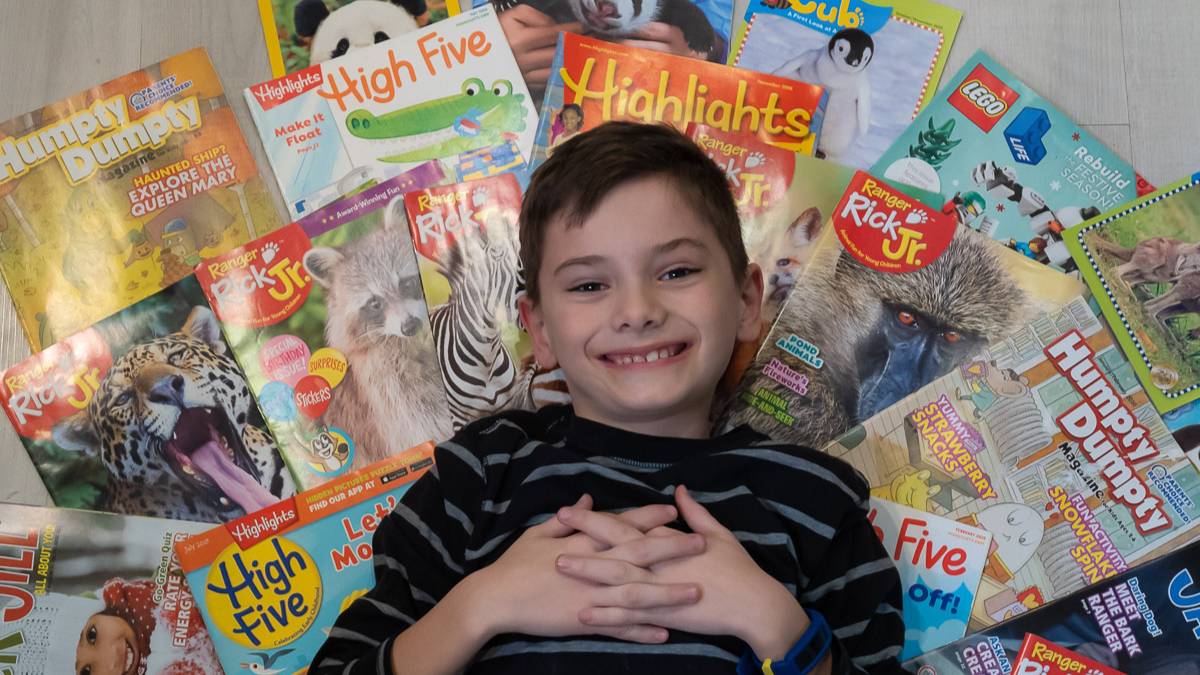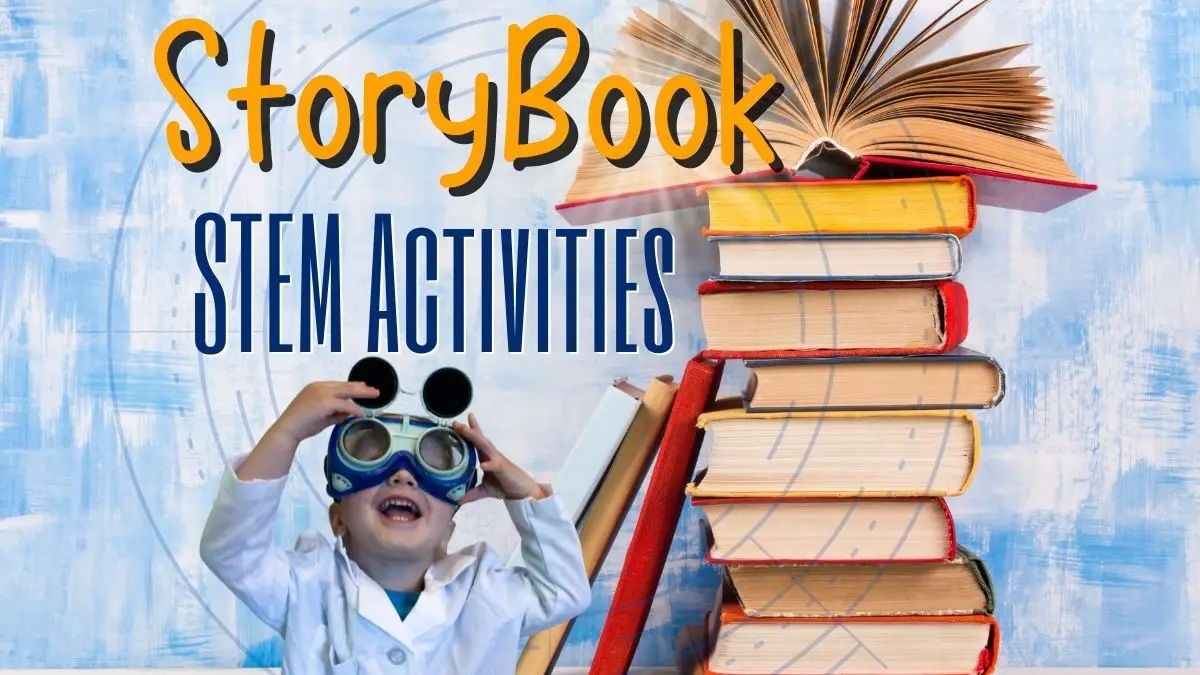Today we’re digging in to a collection of children’s books about female scientists. Against great odds and adversity, women have made some amazing discoveries and contributions to science.
Female scientists have done groundbreaking work in numerous fields, and the picture books here are a great way to introduce science to young readers. The stories also encourage kids to follow their dreams and work towards achieving them. Let’s explore!
by Patrick McDonnell

A list of children’s books about female scientists wouldn’t be complete without mentioning the work of Dr Jane Goodall, and we have several.
Me… Jane takes us through Jane Goodall’s childhood aspirations. With her stuffed monkey companion, Jubilee, her curiosity leads her to discover all she can about nature and wildlife. We see foreshadowing of her later career and life’s work as she (and Jubilee) hide away in a chicken coop the quietly observe chickens laying eggs.
We see Jane climbing trees and dreaming of animals in a whimsical storybook style. These playful images are juxtaposed with illustrations that look like scientific drawings or old-world etchings. The little girl’s dreams and her adult achievements come through in this blend of image styles and add a sense of depth to the book and story.
The last page shows a photograph of Dr Goodall reaching out to a young chimp that echoes the illustrations of her stuffed monkey ever present throughout the book. (We even get to see a photo of young Jane and her stuffed monkey on a biography page in the back of the book.)
Me… Jane is a winner of the Caldecott Honor.
Reading through this book, I can’t help but think of my son’s stuffed monkey companion and wonder what his future holds.

The Watcher: Jane Goodall’s Life with the Chimps
by Jeanette Winter

The Watcher takes us through Jane Goodall’s life and focuses on her accomplishments. We see more of the quiet childhood observation we saw in Me… Jane. Stories of Dr Doolittle and Tarzan fed her imagination. By age 10, she had decided she wanted live among the animals in Africa. We learn how Jane saved up to travel to Africa and landed a job studying chimps.
She set up camp in the jungle and began her work. At first, she can only hear the chimpanzees. Jane stayed persistent through the ensuing months. Building trust through patience, she was finally able to not only see the chimps, but sit among them.
She discovered things about monkeys no one knew at that time. They use simple tools. They eat meat as well as plants. They have a society and range of emotions just as we do.
As deforestation and poachers threatened the African landscape, wildlife, and her beloved chimps, Jane left Africa to share what she had learned and raise awareness.
Stone Girl, Bone Girl – The Story of Mary Anning
by Laurence Anholt
Illustrated by Seiela Moxley

Mary Anning discovered the first fossil of the ichthyosaur, “the fish lizard” in 1811 at the ripe old age of 12. This picture book tells her tale, from surviving a lightning strike as a baby, to hunting for “snake stones” and fossils in Lyme Regis on the coast of England.
Dubbed “Stone Gil, Bone Girl” by her peers, Mary pursued her passion despite the ridicule. Mary later uncovered the first complete plesiosaurus and pterosaurs fossils among hundreds of others fossils still on display in museums around the world.
Look Up!
by Robert Burleigh
Illustrated by Raul Colon

How high is the sky? Ask Henrietta Leavitt, pioneering woman astronomer. As a young girl, Henrietta would stargaze and contemplate how big the sky really was.
Henrietta Leavitt studied astronomy in the 1800s when a woman in the field, or women in science of any kind, was nearly unheard of. When she found work in an observatory, it was merely to study photographs of stars and record data. While pouring over the photos, she noticed that certain stars at times appeared brighter or fainter, and there was a pattern. Her power of observation lead to a discovery to calculate the distance of stars.
Caroline’s Comets: A True Story
by Emily Arnold McCully
Illustrated by Emily Arnold McCully

Raised in Germany
in, childhood ailments left Caroline Herschel stunted and scarred. Her family worried she would never marry or
amount to anything. She relocated to
England with her older brother, William, when she was in her early 20’s and
found work as a maid and singer. Caroline Herschel started with humble
beginnings to become the first “professional woman
scientist.”
Caroline and William shared a fascination with the stars, and together
constructed a powerful telescope. The
telescope led to William Herschel’s discovery of Uranus in 1781. This discovery landed William a job as King
George III’s astronomer. With royal
funding, they constructed more powerful telescopes and began sweeping the sky
and recording stars.
While William was visiting other astronomers throughout Europe, Caroline discovered a comet in 1786, called “The Lady’s Comet.” Caroline later found herself employed by the Crown, and went on to discover seven more comets.
Margaret and the Moon: How Margaret Hamilton Saved the First Lunar Landing
by Dean Robbins
Illustrated by Lucy Knisley

When we think of the Apollo 11 moon landing, astronaut Neil Armstrong gets most of the mention. There was a whole team of people working behind the scenes, and Margaret Hamilton was a key part of the effort.
Margaret was a curious little girl with a love for learning. She excelled in school to find answers to her questions. Once she discovered computers, she found her calling. She started coding and developed software to track airplanes and predict weather (at MIT.)
Moving on to solving more complex problems, she worked for NASA and became Director of Software Programming.
Margaret worked on Apollo 8, Apollo 9, and Apollo 10 missions, developing software to help orbit the moon, to getting closer to the surface. The code she developed had to account for all the things that could possibly go wrong, and how to correct them.
During the pivotal Apollo 11 moon landing mission, an alarm sounded with only moments to go prior to landing. The computer was overloading Margaret’s work allowed the Eagle Lander to clear the problem and touch down on the moon.
Neil Armstrong may be the hero that took the first steps on the moon, though there was a league of heroes behind the scenes like Margaret Hamilton that made the Apollo missions possible.
Related Post: For more books on the moon missions, astronauts, and astronomy, check out our post on space books for kids.
A Computer Called Katherine
by Suzanne Slade
Illustrated by Veronica Miller Jamison

As a little girl, Katherine Johnson loved to count. She enjoyed math because the answers were clear. She skipped a few grades (putting her ahead of her older brother) and completed 8th grade at the age of 10. Schools were segregated, and there were no high schools for kids of color where her family lived. They moved 120 miles so Katherine could continue her education.
Katherine finished college at age 15. Women at this time had limited career choices, so Katherine became a math teacher before finding a job at a research center. She worked with other women known as “computers” crunching numbers and making calculations.
Katherine gained notoriety by asking questions about how the data was used to design flight paths and aircraft, and solving more difficult problems. She was asked to join a research team for a space program.
Katherine made calculations to predict the trajectory of rockets for early astronauts like Alan Shepard and John Glenn. (John Glenn wouldn’t launch until Katherine had confirmed the computers numbers for his first orbit flight.)
When it came time to calculate the flight plan for the first moon landing, Katherine was there.
This is another great story of a young girl who not only accomplished remarkable achievements, but did so in spite of adversity. Overcoming both issues of race and gender Katherine’s sheer talent, ability, and persistence shone through.
Mae Among the Stars
By Roda Ahmed
Illustrated by Stasia Burrington

Mae Jemison had a different way of looking at things, even as a young girl. She wanted to see the earth – from space. She knew she wanted to be an astronaut early on, and share her dream with everyone.
Disheartened after a school teacher suggested that an astronaut was too ambitious and perhaps she should be a nurse instead. Discouraged but not deterred, Mae went on to achieve her dream and became the first woman of color in space.
Mae Among the Stars focuses on a little girl shooting for the stars and hitting the mark. It’s an inspiring story, that goes right from dreams to space.
Mae worked hard to achieve that dream. She studied hard and enrolled in Stanford at age 16. After racking up several degrees, Mae spent some time in the Peace Corps. She applied to NASA’s space program, and in 1992, rocketed into space on the shuttle Endeavour.
After leaving NASA, she got to boldly go where no one has gone before and appeared on an episode of Star Trek:
Ada Lovelace, Poet of Science: The First Computer Programmer
by Diane Stanley
Illustrated by Jessie Hartland

Born Ada Byron, daughter of notable poet Lord Byron and mathematician Anabella (Lady Byron.) She barley knew her father, who died when she was eight. Ada cared little of courts and high society, and found comfort in more intellectual pursuits.
Ada struck up a friendship with Charles Babbage, which led to her working with him on the Analytical Engine, an early punch card machine. Ada translated the manual from French to English, and added a “translators notes” section that was three times as long as the original document. Her notes were essentially the first published computer program.
For more on Ada Lovelace, check out the young adult tile:
Dreaming in Code: Ada Byron Lovelace, Computer Pioneer by Emily Arnold McCully
Grace Hopper: Queen of Computer Code
by Laurie Wallmark
Illustrated by Katie Wu

Grace Hopper’s impact on coding is undeniable. Grace was curious girl who loved to solve problems.
She once took a clock apart to see how it worked. When springs and gears popped out, she couldn’t get it back together. She dismantled seven more clocks to understand how they should work and managed to build a working clock again. She built an elevator for her custom dollhouse as an engineering exercise.
Grace studied math in college, and became a professor at Vassar college. During World War II the Navy put out the call for mathematicians and scientist. When Grace first enlisted, she was rejected for being too old at age 36, but her superior math skills enticed the Navy to enlist Grace anyway.
Grace worked on Navy missile systems, and is responsible for many coding innovations. She developed the concept of reusable blocks of code instead of writing the same functions over and over.
Early programmer used binary language of 1’s and 0’s to program. Grace thought it would be easier if the computers could understand people instead of people having to code in binary. She developed “FLOW-MATIC” on the UNIVAC computer to make programming easier.
Grace and her team discovered the first computer bug. When the Navy’s MARK II computer suddenly halted, they looked for problems with the code and couldn’t find anything. The problem must be elsewhere, so they looked at the machine itself. They found a moth stuck in the machine that was preventing one of the switches from making contact. That’s why we call glitches and computer errors “bugs” today. It started with a literal bug in the machine, and Grace coined the term. You can see Grace’s notes (complete with the bug taped to the page) here at computerhistory.org.
The book is more wordy than some of the others on the list, though still makes a good read. The pictures do well to illustrate the text, and make this a good read along for aspiring young coders.
There are quotes from Grace sprinkled throughout the artwork. It’s worth another venture through the book just to read the quotes.
The book concludes with a timeline of Grace’s life and accomplishments. Forced into retirement at age 60, the Navy soon asked Grace back and a “short” assignment that lasted 20 years. Grace retired from the Navy a second time, as an admiral at age 80.
Nothing Stopped Sophie
by Cheryl Bardoe
Illustrated by Barbara McClintock

The story of Sophie Germain, who in 1816 was the first woman awarded a grand prize from the Royal Academy of Sciences.
As a young girl living through the French Revolution, Sophie was actively discouraged from pursuing her interest in Math. But nothing stopped Sophie.
A demonstration of sand particles moving across a glass plate as a violin bow was drawn across the edge of the glass was the inspiration for much of her future work. She realized that the same waves that moved the sand are all around us. A knock on the door, footfalls on the ground, everything motion was sending vibrations and waves through objects.
She was determined and after many years of study, wrote a formula that accurately predicted vibrational patterns.
Follow up the book with your own experiments about waves! You never know what you may discover.
The Girl with a Mind for Math
by Julia Finley Mosca

The book lightly touches on topics like race, gender bias, and segregation though does it in matter of fact way that doesn’t get in the way of the story – or the protagonist. Instead, these barriers are just hurdles to overcome in a story and life about perseverance. And if this young girl can do it, so can the reader.
Denied entry to an engineering program, Raye studied business and landed a job with the Navy, doing secretarial work. She studied computers, and when much of the staff fell ill under a tight deadline, Raye designed a program to save the day.
The story is written in a flowing rhyming couplet. In the back, it includes a timeline of Raye’s life, as well as a biography and some inspiration words from Raye herself.
Related Post: 11 Outstanding Math Books for Preschoolers
How to Build a Hug: Temple Grandin and Her Amazing Squeeze Machine
by Amy Guglielmo and Jaqueline Tourville

Dr Temple Grandin is best known for her work for the humane treatment of animals and advances in cattle care.
As a child Temple craved the feeling of a hug, but was not a fan of being touched. How to Build a Hug takes us through her early life and how she built her own hug machine to simulate the feeling of a gentle squeeze. The hug machine is based off of a device used to hold cattle still for veterinary work.
The hug machine outlines how inspiration and innovation can help guide us towards solutions for unique problems.
Dr Temple Grandin is open and outspoken on autism
Bonus Book: Girls Think of Everything
by Catherine Thimmish
Illustrated by Melissa Sweet

Girls Think of Everything highlights notable inventions by women. From items as diverse as kevlar, paper bags, liquid paper, or chocolate chip cookies women have invented some of the things we take for granted.
Grace Hopper gets mention in Girls Think of Everything for the computer compiler, though many of these women you’ve probably never heard of.
Windshield wipers? Yep, Mary Anderson’s brain child. Glow in the dark paper (Glo-Sheet) – that was 10 year old Becky Schroeder, who became the youngest female to obtain a US patent.
You’d be surprised by some of the stories!
Wrap up: Children’s Books About Female Scientists
Wow, what a collection of inspiring stories and discoveries! From digging dinosaurs to discovering celestial bodies and reaching the stars, women have achieved groundbreaking work. Where do you think science would be without their grit and knowledge?
Want to grab some of these books? Check out your local library, and don’t miss our post on why every kids needs a library card.
-
Library Card for Kids: Why the Need Them & How to Get One

Are you looking for a way to boost your child’s love of learning and reading? Check out your local library! Getting a library card for your child can open up
-
Encourage a Love of Reading with the Best Magazines for Kids

Though screens are constantly competing for our kid’s attention, magazines are still alive and kicking. Educational magazines for kids are a great way to engage the minds of young readers
-
STEM Activities That Go with Books

STEM activities are great for kids and parents alike. They provide hours of fun while teaching important skills such as problem solving, collaboration, critical thinking, creativity, and teamwork. Kids’ books


